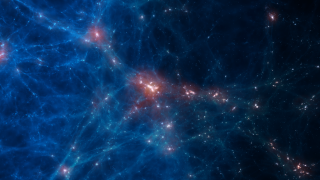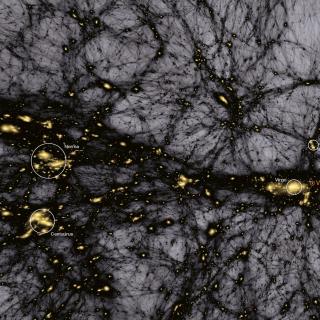Schaye, Joop; Theuns, Tom; Schaller, Matthieu; Frenk, Carlos S.; Dalla Vecchia, C.; Crain, Robert A.; Sales, Laura V.; Bower, Richard G.; Abadi, Mario G.; Navarro, Julio F.; Algorry, David G.
Referencia bibliográfica
Monthly Notices of the Royal Astronomical Society, Volume 469, Issue 1, p.1054-1064
Fecha de publicación:
7
2017
Número de citas
111
Número de citas referidas
109
Descripción
We examine the properties of barred disc galaxies in a ΛCDM
cosmological hydrodynamical simulation from the EAGLE project. Our study
follows the formation of 269 discs identified at z = 0 in the stellar
mass range 10.6 < log M*/M⊙ < 11. These
discs show a wide range of bar strengths, from unbarred discs (≈60
per cent) to weak bars (≈20 per cent) and to strongly barred systems
(≈20 per cent). Bars in these systems develop after redshift ≈1.3,
on time-scales that depend sensitively on the strength of the pattern.
Strong bars develop relatively quickly (in a few Gyr, or roughly ∼10
disc rotation periods) in systems that are disc dominated, gas poor, and
have declining rotation curves. Weak bars develop more slowly in systems
where the disc is less gravitationally important, and are still growing
at z = 0. Unbarred galaxies are comparatively gas-rich discs whose
rotation speeds do not exceed the maximum circular velocity of the
haloes they inhabit. Bar lengths compare favourably with observations,
ranging from 0.2 to 0.8 times the radius containing 90 per cent of the
stars. Bars slow down remarkably quickly as they grow, causing the inner
regions of the surrounding dark halo to expand. At z = 0 strong bars in
simulated galaxies have corotation radii roughly 10 times the bar
length. Such slow bars are inconsistent with the few cases where pattern
speeds have been measured or inferred observationally, a discrepancy
that, if confirmed, might prove a challenge for disc galaxy formation in
ΛCDM.
Proyectos relacionados

Astrofísica Numérica: Formación y Evolución de Galaxias
Entre las cuestiones fundamentales en Astronomía y Astrofísica están la formación y evolución de galaxias. Las escalas de tiempo y tamaño son tan astronómicas que su observación en galaxias individuales es imposible. Solo con el uso de simulaciones numéricas es posible entender la formación de estructuras cósmicas dentro del actual marco
Claudio
Dalla Vecchia

Cosmología con Trazadores de la Estructura a Gran Escala del Universo
El Fondo Cósmico de Microondas (FCM) contiene la información estadística de las semillas primigenias que han dado lugar a la formación de todas las estructuras en el Universo. Su contrapartida natural en el Universo local es la distribución de las galaxias que surgen como resultado del crecimiento gravitatorio de aquellas fluctuaciones de densidad
FRANCISCO SHU
KITAURA JOYANES